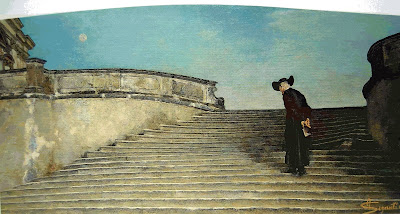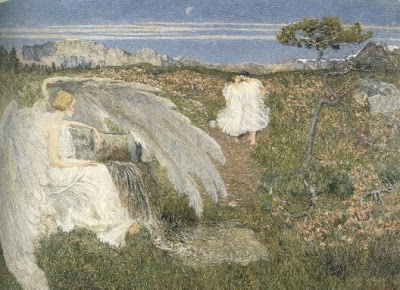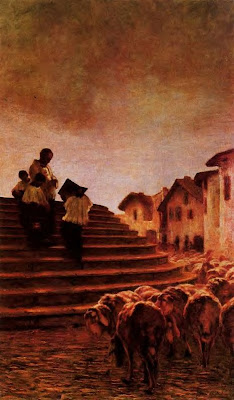 Giovanni Segantini (January 15, 1858 - September 28, 1899)
Giovanni Segantini (January 15, 1858 - September 28, 1899)Choir of St Anthony 1879,
119x85 cm, Oil on Canvas,
Private Collection
 Giovanni Segantini (January 15, 1858 - September 28, 1899)
Giovanni Segantini (January 15, 1858 - September 28, 1899)Ave Maria a trasbordo (1st version) 1882
Oil on Canvas , cm 84x64,5
Private collection, Zurich
 Giovanni Segantini (January 15, 1858 - September 28, 1899)
Giovanni Segantini (January 15, 1858 - September 28, 1899)Frühmesse, 1885/86,
108x211cm, Oil on canvas
Kunstmuseum St. Gallen
 Giovanni Segantini (Italian, 1858-1899)
Giovanni Segantini (Italian, 1858-1899)L’amore alla fonte della vita (or La fonte della giovinezza, Gli amanti alla fonte della vita) 1896 Oil on canvas, cm 70x98
Civica Galleria d’Arte Moderna, Milan
 Giovanni Segantini (Italian, 1858-1899)
Giovanni Segantini (Italian, 1858-1899)L'angelo della vita (Angel of Life) 1896
cm 59,5x43
St.Moritz, Museum Segantini
 Giovanni Segantini (Italian, 1858-1899)
Giovanni Segantini (Italian, 1858-1899)The Punishment of Lust 1891
Oil on canvas, 99 x 172.8cm
Walker Art Gallery, Liverpool
 Giovanni Segantini (Italian, 1858-1899)
Giovanni Segantini (Italian, 1858-1899)Il dolore confortato dalla Fede (Il conforto della Fede)
Oil canvas 85.5 x 132 cm;
Kunsthalle. Hamburg
 Giovanni Segantini (Italian, 1858-1899)
Giovanni Segantini (Italian, 1858-1899)The Fruits of Love 1889.
88.2 x 57.2cm.
Museum der bildenden Künste. Leipzig
 Giovanni Segantini (Italian, 1858-1899)
Giovanni Segantini (Italian, 1858-1899)Benedizione delle pecore (Blessing of the sheep)1884.
198 x 120 cm.
St.Moritz, Museum Segantini
Giovanni Segantini (January 15, 1858 - September 28, 1899) came from an old mountain family in Arco, near Lake Garda, Italy.
At age seven he ran away and was later found perishing of cold and hunger.He began to earn his bread by herding flocks in the hills and there he spent his long hours of solitude in drawing.
After more flights and more returns, Segantini finally settled in Milan to attend classes at the Brera. In Milan he was able to earn a living by teaching art and painting portraits.
His first picture, The Choir of Sant Antonio was noticed for its powerful quality. In it he used a technique, similar to Pointillism or Neo-Impressionism, that he had developed, apparently, simply by means of observing light and color at first hand.
He settled in Brianza, near Como. There he gave himself up to the study of mountain life, and became the painter of the Alps.
At this time he painted the Ave Maria, which took a gold medal at the Amsterdam Exhibition (1883),
Segantini died at Maloja in October 1899 while working on his famous piece Alpentriptychon.
For more see
The Segantini Museum (San Moritz)
For an interesting commentary on his life and one of his works see The Walker Art Gallery, Liverpool: Artwork of the Month - March, 2000 'The Punishment of Lust, also known as The Punishment of Luxury, 1891', by Giovanni Segantini (1858-1899)

No comments:
Post a Comment